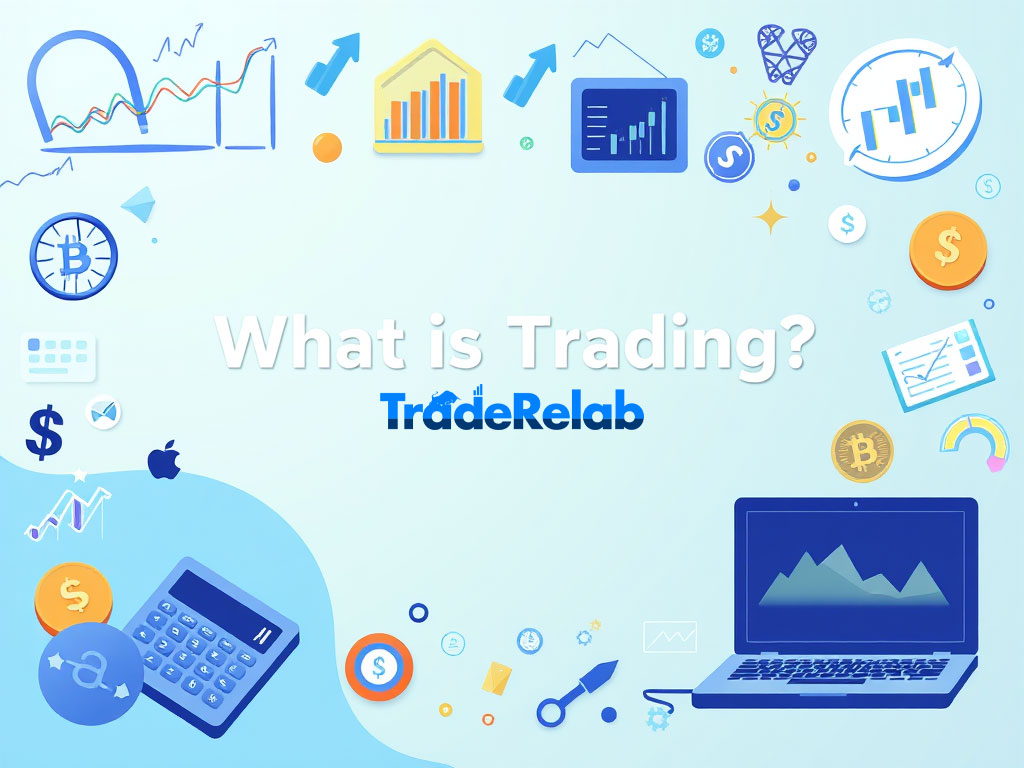What is Trading? A Beginner’s Guide

Trading may seem complex at first, but understanding its basics can help you make informed investment decisions.

This guide covers fundamental concepts, different types of markets, essential strategies, and risk management techniques to help you trade with confidence.
Key Takeaways
- Trading involves buying and selling assets to generate profits.
- Understanding market trends and risk management is crucial.
- There are different types of trading markets, including stocks, forex, and commodities.
- Various trading styles, such as day trading and swing trading, cater to different risk levels.
- Successful trading requires discipline, continuous learning, and strategic planning.
Understanding the Basics of Trading
Trading is the process of exchanging financial assets, such as stocks, currencies, and commodities, with the goal of making a profit. To navigate the markets effectively, traders must understand key concepts such as:
- Buy and Sell Orders: Instructions to purchase or sell assets at specific prices.
- Market Trends and Analysis: Understanding how asset prices move over time.
- Risk Management Strategies: Techniques to minimize losses and protect capital.
Each financial market operates differently, and understanding their unique features helps traders make better decisions.
Why is Trading Important?
Trading plays a crucial role in the global economy, offering numerous benefits to individuals and businesses. It provides opportunities for financial growth, portfolio diversification, and passive income generation. Some key benefits of trading include:
- Diversification: Reducing risk by investing in different asset classes.
- Profit Potential: Earning from market fluctuations and price changes.
- Accessibility: Online trading platforms make it easier than ever to participate in global markets.
With the increasing use of digital tools, trading has become more accessible, allowing individuals to grow their wealth over time.
Different Types of Trading Markets
Trading markets offer various opportunities for investors. Some of the most popular markets include:
- Stock Market: Buying and selling shares of publicly traded companies.
- Forex Market: Trading global currencies based on exchange rate fluctuations.
- Cryptocurrency Market: Investing in digital currencies like Bitcoin and Ethereum.
- Commodities Market: Trading raw materials such as gold, oil, and agricultural products.
Each market comes with its own risks and rewards, and understanding them is essential for making informed investment decisions.
Essential Trading Styles and Approaches
Different trading styles suit different financial goals and risk tolerances. Some common trading styles include:
- Day Trading: Buying and selling within the same day to take advantage of short-term price movements.
- Swing Trading: Holding positions for days or weeks to benefit from medium-term trends.
- Position Trading: Holding assets for months or years based on long-term market trends.

Choosing the right trading style depends on factors such as available time, risk appetite, and investment goals.
Understanding Trading Risk Management
Managing risk is an essential aspect of successful trading. Effective risk management strategies include:
- Position Sizing: Allocating appropriate capital to each trade to limit potential losses.
- Stop-Loss Orders: Automatically closing trades when they reach a predefined loss level.
- Portfolio Diversification: Spreading investments across multiple assets to reduce exposure to a single market.
By implementing these risk management techniques, traders can minimize losses and enhance long-term profitability.
Getting Started with Your First Trade
If you’re new to trading, follow these steps to start confidently:
- Choose a Reliable Trading Platform: Research platforms with user-friendly interfaces and competitive fees.
- Open and Fund Your Account: Provide necessary personal and financial information to begin trading.
- Practice with a Demo Account: Test strategies with virtual funds before using real money.
- Analyze the Markets: Use charts, indicators, and research tools to make informed decisions.
- Start Small: Begin with a modest investment and gradually increase your exposure.
Taking a disciplined approach will help you develop confidence and refine your trading skills over time.
Common Trading Mistakes to Avoid
Many traders make avoidable mistakes that can lead to losses. Some common pitfalls include:
- Emotional Trading: Making impulsive decisions based on fear or greed.
- Lack of Research: Failing to analyze market trends and asset performance.
- Overtrading: Executing too many trades without a solid strategy.
To avoid these mistakes, traders should stick to their trading plans, continuously educate themselves, and remain patient.
Tools and Resources for New Traders
Successful trading requires access to the right tools and resources, including:
- Trading Platforms: MetaTrader, TradingView, and eToro offer advanced charting and analysis tools.
- Educational Resources: Online courses, books, and webinars can provide valuable insights.
- Market Analysis Tools: Fundamental and technical analysis help traders make informed decisions.
Using these tools can enhance trading performance and increase the chances of success.

Conclusion: Your Path to Trading Success
Trading is a journey that requires patience, discipline, and continuous learning. By understanding market fundamentals, developing a solid strategy, and managing risks effectively, traders can increase their chances of long-term success.
Start small, refine your skills, and stay informed. With the right mindset and tools, you can navigate the trading world and achieve your financial goals.
FAQ
What is trading?
Trading involves buying and selling financial assets, such as stocks and currencies, to generate profits.
What are the key trading terms I should know?
Important terms include market orders, stop-loss, leverage, volatility, and portfolio diversification.
Why is trading important?
Trading allows individuals to grow their wealth, diversify investments, and take advantage of market opportunities.
What are the different types of trading markets?
Popular markets include stocks, forex, cryptocurrencies, and commodities.
What are the essential trading styles and approaches?
Common styles include day trading, swing trading, and position trading.
How can I manage trading risks?
Use stop-loss orders, position sizing, and portfolio diversification to reduce risk.
How do I get started with my first trade?
Choose a trading platform, open an account, practice with a demo, and start with a small investment.
What are the common trading mistakes I should avoid?
Avoid emotional trading, lack of research, and overtrading.
What tools and resources are available for new traders?
Trading platforms, educational courses, and market analysis tools help improve trading skills.






